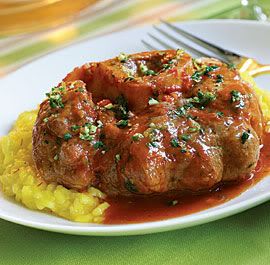|
|
RE: Now, That's Italian!
1/19/2012 10:48:44 PM
|
Hello Friends, Since they were playing games with our Internet yesterday, I'm afraid that I'll just have to play catch up today. This is the world’s best make-ahead dish—it tastes amazing on the second day. It's paired with the classic accompaniment, saffron-scented Risotto alla Milanese. Osso Buco 
Ingredients:
6 1-1/4 inch-thick veal shanks
Kosher salt and freshly ground black pepper
1/2 cup all-purpose flour for dredging
1/4 cup extra-virgin olive oil
1 Tbs. unsalted butter
3 cups finely diced yellow onion (about 2 medium onions)
1 cup finely diced celery (about 2 stalks)
3/4 cup finely diced carrot (about 2 small carrots)
1 tsp. dried oregano
3/4 cup dry white wine
2 Tbs. tomato paste
1 28-oz. can Italian plum tomatoes, drained and chopped, juices reserved
1 cup low-salt chicken broth, more if needed
1 large sprig thyme
1 bay leaf
1 Tbs. arrowroot mixed with 2 tsp. broth or water Tip: Look for arrowroot in the spice section of your grocery store. For the gremolata:
3 Tbs. finely chopped fresh flat-leaf parsley
2 large cloves garlic, minced
1 Tbs. finely grated lemon zest
2 anchovy fillets, minced Directions: Heat the oven to 350°F. Tie the veal shanks around the middle with kitchen string (if they’re not tied already) and season them with salt and pepper. Put the flour in a dish. Dredge the shanks very lightly in flour, thoroughly shaking off the excess. Have ready a roasting pan or baking dish large enough to hold the shanks in a single layer (9x13-inch works well). In a large heavy skillet, heat 3 Tbs. of the oil over medium-high heat. Put three veal shanks in the pan and sear until nicely browned on both sides, 2 to 3 minutes per side. Move the shanks to the roasting pan. Repeat with the remaining three shanks. Carefully pour off the fat in the pan and wipe it out with paper towels (it’s fine if the browned bits remain in the pan bottom; just wipe away the used oil). Return the pan to medium heat and add the butter and remaining 1 Tbs. of oil. When the butter is melted, add the onion, celery, carrot, oregano, and 1 tsp. salt. Cook the vegetables, stirring occasionally, until soft and lightly browned, 15 to 20 minutes. Increase the heat to medium-high, add the wine, and cook, scraping up any brown bits with a wooden spoon, until the wine is reduced to about 1/4 cup, about 3 minutes Stir in the tomato paste. Add the tomatoes with their juices, the broth, thyme, bay leaf, 1/2 tsp. salt, and a few grinds of pepper. Bring to a boil, and pour the contents of the pan over the shanks. Cover tightly with heavy-duty aluminum foil. Braise the veal in the oven until fork-tender, 1-1/2 to 2 hours, checking the liquid occasionally. If it has cooked down, add enough broth to keep the level about halfway up the shanks. To check for doneness, pierce a shank with a fork. The meat should pull apart easily. Taste a morsel—it should feel soft and tender. Do not overcook, or the veal will fall apart. Gently brush most of the vegetable bits off the shanks. With a wide, flat metal spatula, carefully transfer the veal shanks to a dish. Strain the pan juices through a medium-mesh sieve into a saucepan, pressing hard on the solids with a spatula to extract as much sauce as you can. Bring the sauce to a simmer. Whisk in the arrowroot mixture and cook briefly to thicken. If you’re working ahead, stop here (see Make-ahead Tips for reheating). Make the gremolata: Just before finishing the sauce and serving, combine the parsley, garlic, lemon zest, and anchovies. Add two Tbs. of the gremolata to the sauce. Remove the strings from the shanks. Serve the osso buco topped with the sauce and a small sprinkling of the remaining gremolata. Serves 6. Make Ahead Tips To make the osso buco ahead, braise the veal and strain and thicken the sauce with arrowroot. Wipe the roasting pan clean, return the shanks to the pan, and pour the sauce over the shanks. Let them cool at room temperature for an hour, cover well, and refrigerate for up to two days. To reheat, cover the pan with foil and set in a 325°F oven until the shanks are hot, 30 to 35 minutes. Transfer the shanks to a dish, then make the gremolata, adding it to the sauce and sprinkling it over the shanks. While it would be unfair to say that this is the risotto after which all others are derived—the Venetians provide plenty of competition—its lovely simplicity is hard to match. If you're uneasy about risotto, this is a good recipe to start with because it's simple and requires so few ingredients. Risotto alla Milanese 
Ingredients:
1 medium onion, very finely chopped
8 Tbs. unsalted butter
1 lb. (2 cups) arborio, vialone nano, or carnaroli rice, or other medium- or short-grain Italian rice
1/2 cup dry white wine
6 cups hot homemade or low-salt canned chicken broth; more as needed
1/2 tsp. saffron threads
1 cup finely grated parmesan, preferably Parmigiano-Reggiano
Salt and freshly ground black pepper to taste Directions: In a heavy-based saucepan that's large enough to hold the rice with plenty of room left over, cook the onion in 2 tablespoons of the butter over medium heat until it's translucent and fragrant, about 5 minutes. Stir in the rice and cook it over medium heat for about 3 minutes. Add the wine, 2 cups of broth, and the saffron. Turn the heat to high until the broth comes to a simmer and then adjust the heat to maintain a steady simmer. Cook until most of the liquid has been absorbed, stirring every minute or two (there's no need to stir constantly). Add another cup of broth and keep cooking, stirring, and adding broth until the rice is al dente but not raw or grainy in the middle. When the rice is ready, stir in the cheese. Add a little more broth to give the risotto the consistency you like (from fairly tight to almost soupy). Off the heat, stir in the remaining 6 tablespoons butter. Season with salt and pepper and ladle onto heated plates or bowls. Serves 6. (If you have any leftover risotto, it's delicious made into crunchy Risotto Cakes) 
Have A Delightful Thursday, Phil
|